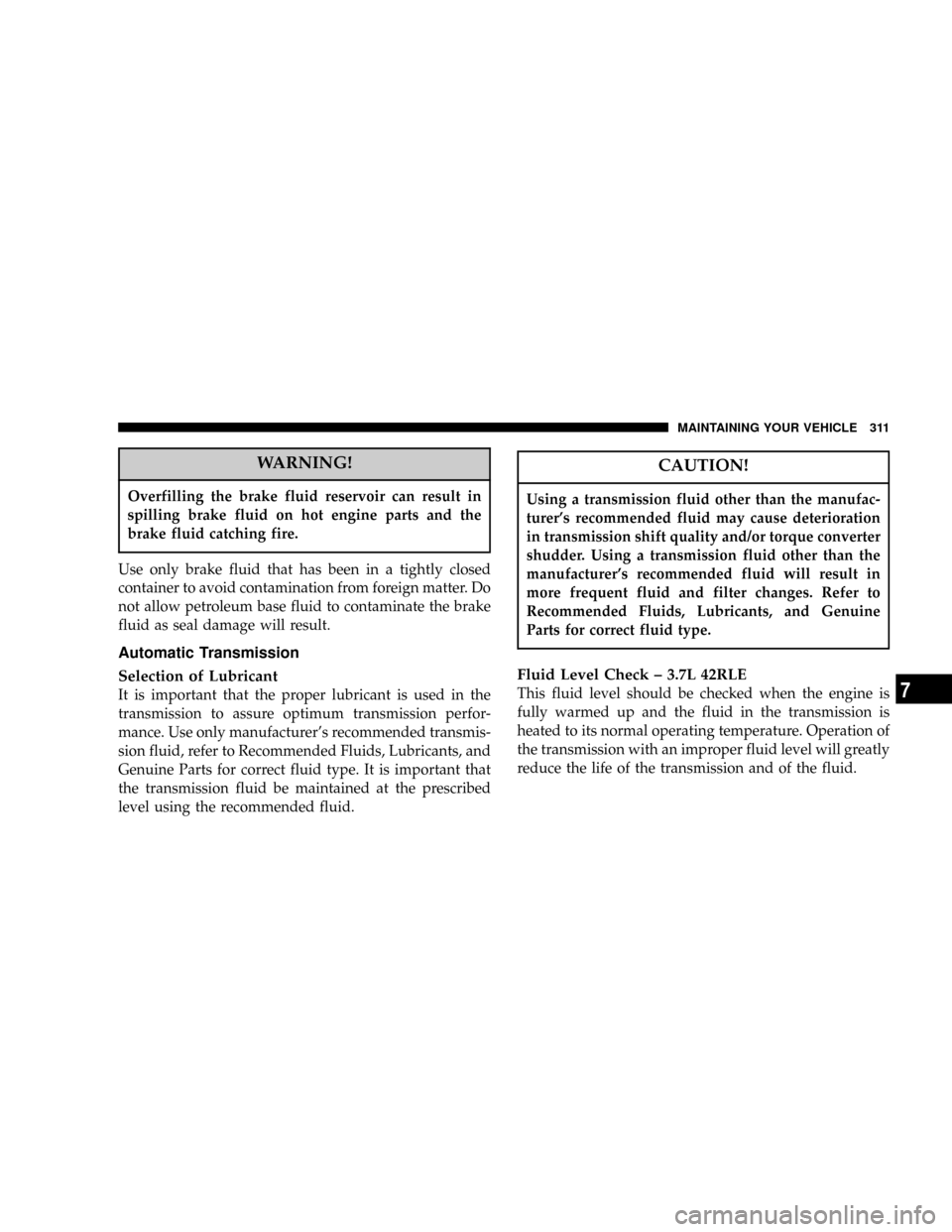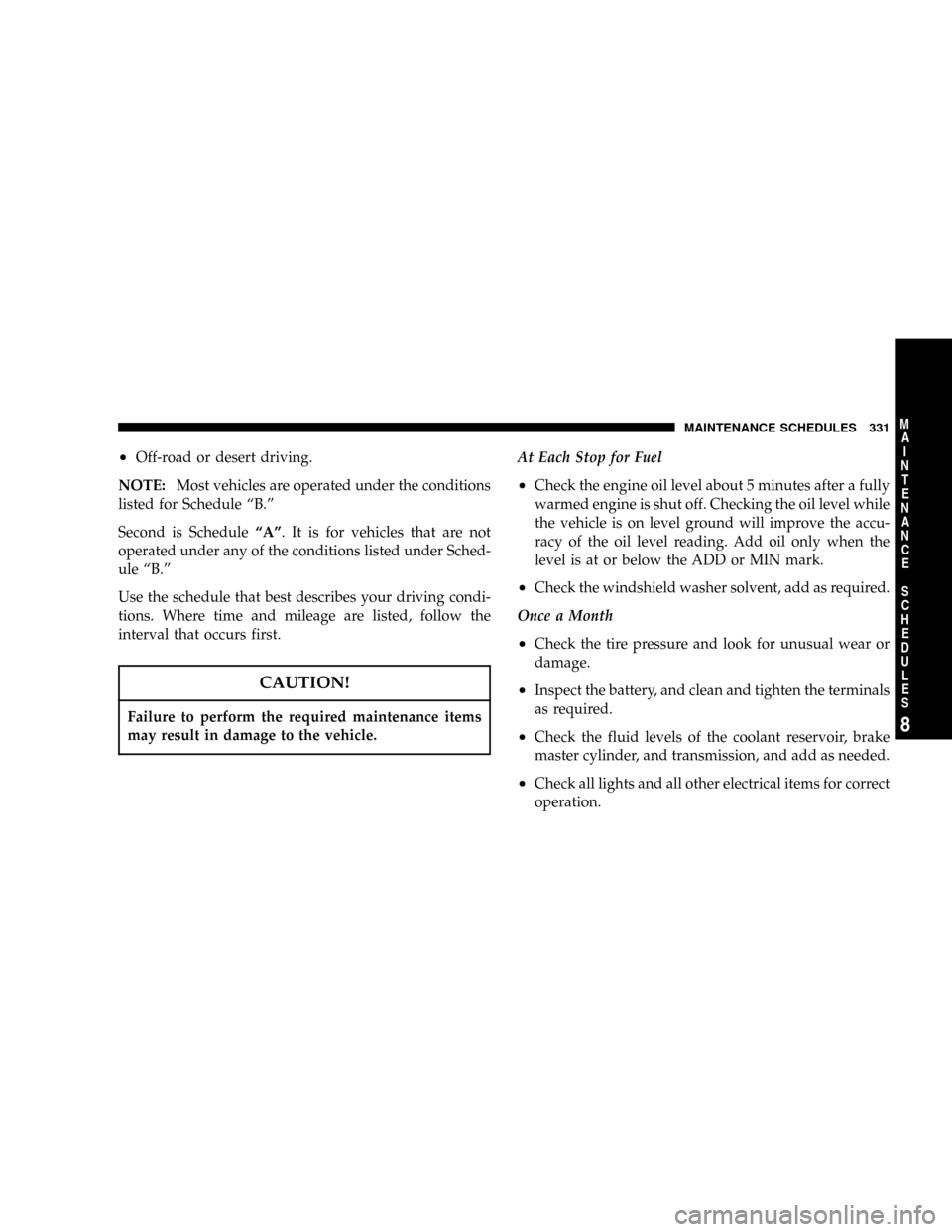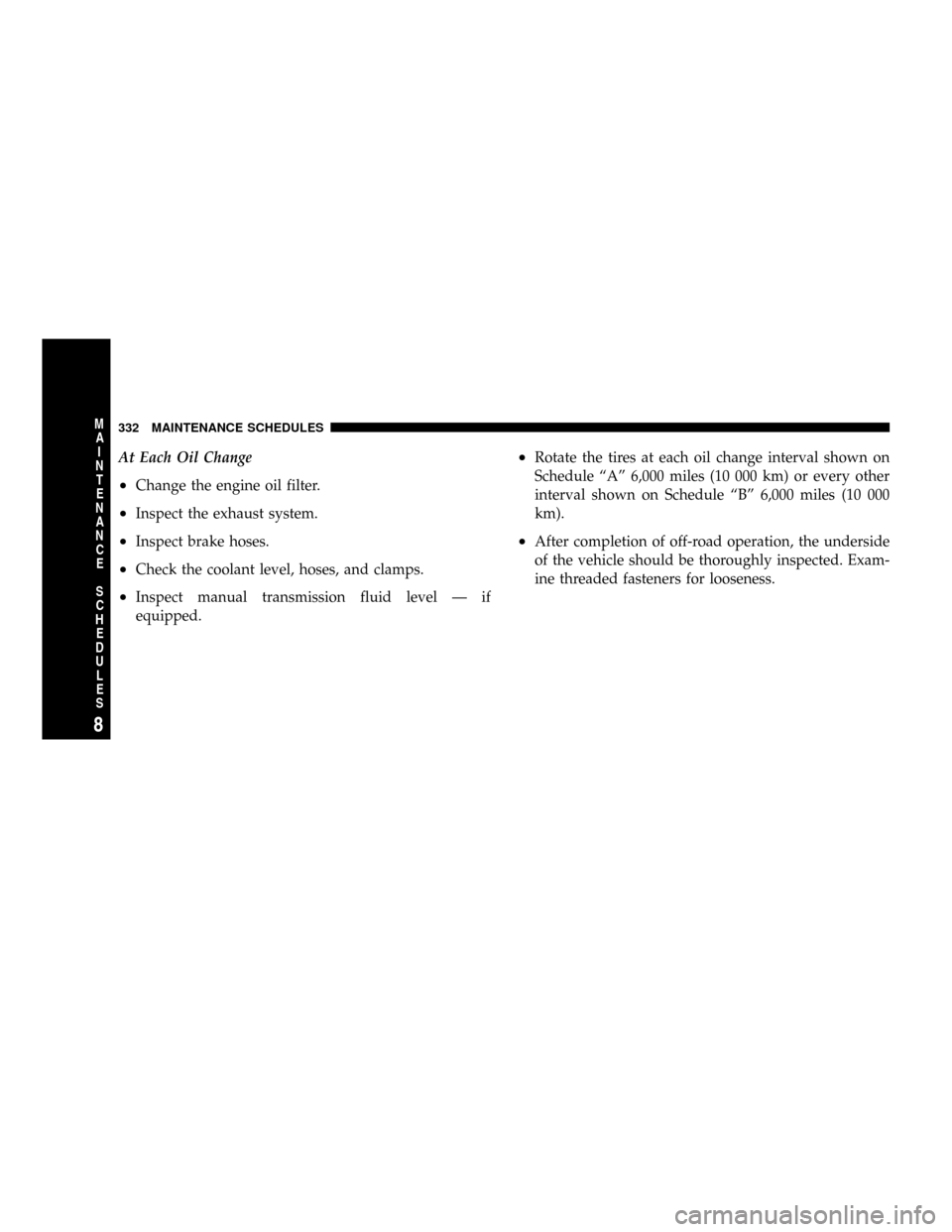2004 JEEP LIBERTY check transmission fluid
[x] Cancel search: check transmission fluidPage 155 of 374

14. Cruise Indicator Light
This indicator lights when the speed control
system is turned ON.
15. Oil Pressure Warning Light
Shows low engine oil pressure. The light will come
on and remain on when the ignition switch is
turned from the OFF to the ON position, and the light
will turn off after the engine is started. If the bulb does
not come on, have the system checked by your autho-
rized dealer.
If the warning light comes on and remains on while
driving, stop the vehicle and shut off the engine. DO
NOT OPERATE THE VEHICLE UNTIL THE CAUSE IS
CORRECTED. Also, a single chime will sound.
16. Transmission Temperature Warning Light
This light indicates that there is excessive trans-
mission fluid temperature that might occur with
severe usage such as trailer towing or snow plowing. Ifthis light comes on, stop the vehicle and run the engine at
idle or faster, with the transmission in N (Neutral) until
the light goes off.
17. Part Time Indicator Light Ð If Equipped
This light alerts the driver that the vehicle is in
the PART TIME four±wheel drive high range
mode, and the front and rear driveshafts are
mechanically locked together forcing the front and rear
wheels to rotate at the same speed.
18. Brake Warning Light
This light monitors various brake functions,
including brake fluid level and parking brake
application. If the light comes on, it may indi-
cate that the parking brake is applied, or there
is a low brake fluid level. On vehicles equipped with
Anti-Lock brakes (ABS), it may also indicate an ABS
malfunction that could lead to reduced braking perfor-
mance.
UNDERSTANDING YOUR INSTRUMENT PANEL 155
4
Page 284 of 374

NPower Steering Fluid Check..............300
NDriveline And Steering Component
Lubrication..........................301
NBody Lubrication.....................301
NWindshield Wiper Blades................301
NWindshield Washers...................302
NExhaust System......................302
NCooling System.......................303
NHoses And Vacuum/Vapor Harnesses.......307
NBrake System........................308
NAutomatic Transmission................311
NHydraulic Clutch Fluid
Ð Manual Transmission................313
NManual Transmission..................313NTransfer Case........................313
NFront/Rear Axle Fluid..................315
NAppearance Care And Protection From
Corrosion...........................315
mFuse Panel...........................320
NInterior Fuses........................320
N
Underhood Fuses (Power Distribution Center). 323
mVehicle Storage........................324
mReplacement Bulbs......................324
mFluid Capacities........................326
mRecommended Fluids, Lubricants And Genuine
Parts................................327
NEngine.............................327
NChassis............................328
284 MAINTAINING YOUR VEHICLE
Page 311 of 374

WARNING!
Overfilling the brake fluid reservoir can result in
spilling brake fluid on hot engine parts and the
brake fluid catching fire.
Use only brake fluid that has been in a tightly closed
container to avoid contamination from foreign matter. Do
not allow petroleum base fluid to contaminate the brake
fluid as seal damage will result.
Automatic Transmission
Selection of Lubricant
It is important that the proper lubricant is used in the
transmission to assure optimum transmission perfor-
mance. Use only manufacturer's recommended transmis-
sion fluid, refer to Recommended Fluids, Lubricants, and
Genuine Parts for correct fluid type. It is important that
the transmission fluid be maintained at the prescribed
level using the recommended fluid.
CAUTION!
Using a transmission fluid other than the manufac-
turer's recommended fluid may cause deterioration
in transmission shift quality and/or torque converter
shudder. Using a transmission fluid other than the
manufacturer's recommended fluid will result in
more frequent fluid and filter changes. Refer to
Recommended Fluids, Lubricants, and Genuine
Parts for correct fluid type.
Fluid Level Check ± 3.7L 42RLE
This fluid level should be checked when the engine is
fully warmed up and the fluid in the transmission is
heated to its normal operating temperature. Operation of
the transmission with an improper fluid level will greatly
reduce the life of the transmission and of the fluid.
MAINTAINING YOUR VEHICLE 311
7
Page 312 of 374

To check the automatic transmission fluid level properly,
the following procedure must be used:
1. The vehicle must be on level ground.
2. The engine should be running at curb idle speed for a
minimum of 60 seconds.
3. Fully apply parking brake.
4. Apply the brakes and shift the transmission into P
(Park).
5. The fluidMUSTbe checked with the transmission in
P (Park) to be sure that the fluid level is accurate.
6. Wipe the dipstick clean and reinsert until seated.
Remove dipstick and note reading.
At normal operating temperature (approximately 180É F
(82É C), the fluid level is correct if it is in the HOT region(cross-hatched area) on the oil level indicator. The fluid
level indicator should be in the COLD region at 70É F (21É
C) fluid temperature.
If the fluid level is low, add sufficient fluid to bring to the
proper level. Refer to Recommended Fluids, Lubricants
and Genuine Parts for correct fluid type.
Fluid is added through the dipstick tube.
NOTE:To prevent dirt and water from entering the
transmission after checking or replenishing fluid, make
certain that the dipstick cap is properly reseated.
Special Additives
The manufacturer recommends against the addition of
any additives to the transmission. Exception to this
policy is the use of special dyes to aid in detecting fluid
leaks.
312 MAINTAINING YOUR VEHICLE
Page 313 of 374

Hydraulic Clutch Fluid Ð Manual Transmission
The clutch hydraulic system is a sealed maintenance free
system. In the event of leakage or other malfunction, the
system must be replaced.
Manual Transmission
Selection of Lubricant
Use only manufacturer's recommended manual trans-
mission fluid, refer to Recommended Fluids, Lubricants,
and Genuine Parts for correct fluid type.
Fluid Level Check
Check the fluid level by removing the fill plug. The fluid
level should be between the bottom of the fill hole and a
point not more than 3/16º (4.76 mm) below the bottom of
the hole.
Add fluid, if necessary, to maintain the proper level.
Frequency of Fluid Change
Under normal operating conditions, the fluid installed at
the factory will give satisfactory lubrication for the life of
the vehicle. Fluid changes are not necessary unless the
lubricant has become contaminated with water. If con-
taminated with water, the fluid should be changed im-
mediately.
Transfer Case
Fluid Level Check
Inspect the transfer case for fluid leaks. If a fluid leak is
evident, the transfer case fluid level can be checked by
removing the fill plug (B) located at the back of the
transfer case.
MAINTAINING YOUR VEHICLE 313
7
Page 331 of 374

²Off-road or desert driving.
NOTE:Most vehicles are operated under the conditions
listed for Schedule ªB.º
Second is ScheduleªAº. It is for vehicles that are not
operated under any of the conditions listed under Sched-
ule ªB.º
Use the schedule that best describes your driving condi-
tions. Where time and mileage are listed, follow the
interval that occurs first.
CAUTION!
Failure to perform the required maintenance items
may result in damage to the vehicle.
At Each Stop for Fuel
²Check the engine oil level about 5 minutes after a fully
warmed engine is shut off. Checking the oil level while
the vehicle is on level ground will improve the accu-
racy of the oil level reading. Add oil only when the
level is at or below the ADD or MIN mark.
²Check the windshield washer solvent, add as required.
Once a Month
²Check the tire pressure and look for unusual wear or
damage.
²Inspect the battery, and clean and tighten the terminals
as required.
²Check the fluid levels of the coolant reservoir, brake
master cylinder, and transmission, and add as needed.
²Check all lights and all other electrical items for correct
operation.
MAINTENANCE SCHEDULES 331
8
M
A
I
N
T
E
N
A
N
C
E
S
C
H
E
D
U
L
E
S
Page 332 of 374

At Each Oil Change
²Change the engine oil filter.
²Inspect the exhaust system.
²Inspect brake hoses.
²Check the coolant level, hoses, and clamps.
²Inspect manual transmission fluid level Ð if
equipped.
²Rotate the tires at each oil change interval shown on
Schedule ªAº 6,000 miles (10 000 km) or every other
interval shown on Schedule ªBº 6,000 miles (10 000
km).
²After completion of off-road operation, the underside
of the vehicle should be thoroughly inspected. Exam-
ine threaded fasteners for looseness.
332 MAINTENANCE SCHEDULES
8
M
A
I
N
T
E
N
A
N
C
E
S
C
H
E
D
U
L
E
S
Page 358 of 374

Adding Washer Fluid..................... 204
Air Cleaner, Engine...................... 297
Air Conditioner Maintenance............... 299
Air Conditioning........................ 200
Air Conditioning Controls...............200,201
Air Conditioning, Operating Tips............ 202
Air Conditioning Refrigerant............... 300
Air Conditioning System.................. 200
Air Filter.............................. 297
Air Pressure, Tires....................... 249
Airbag................................ 46
Airbag Deployment....................... 55
Airbag Light.......................51,58,157
Airbag Maintenance....................... 57
Airbag, Window......................... 47
Alarm................................ 28
Alarm, Panic............................ 25
Alignment and Balance................... 253
Alterations/Modifications, Vehicle............. 8Antenna, Satellite Radio................... 193
Antifreeze (Engine Coolant)................ 326
Anti-Lock Brake System................... 234
Anti-Lock Warning Light.................. 152
Appearance Care........................ 315
Arming Theft System...................... 28
Auto Down Power Windows................ 33
Automatic Dimming Mirror................. 76
Automatic Door Locks..................... 21
Automatic Transmission................216,311
Adding Fluid......................... 312
Fluid and Filter Changes................. 311
Fluid Level Check...................... 311
Fluid Type........................... 311
Gear Ranges.......................... 217
Shifting............................. 216
Special Additives...................... 312
Torque Converter...................... 221
Auxiliary Electrical Outlet.................. 133
358 INDEX